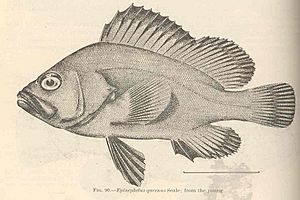Pseudorhabdosynochus querni facts for kids
Quick facts for kids Pseudorhabdosynochus querni |
|
|---|---|
| Scientific classification | |
| Genus: |
Pseudorhabdosynochus
|
| Species: |
querni
|

Pseudorhabdosynochus querni is a tiny parasite that lives on the gills of a fish called the Hawaiian grouper. It belongs to a group of flatworms known as monogeneans. These worms are very small and can only be seen well with a microscope.
This interesting creature was first discovered and described in 1968 by a scientist named Satyu Yamaguti. He first called it Diplectanum querni. Later, in 1986, it was moved to a different group, or genus, called Pseudorhabdosynochus. Scientists looked at it again in 2005 to learn even more about its features.
Contents
Meet the Gill Worm: Pseudorhabdosynochus querni
Pseudorhabdosynochus querni is a very small worm. It measures about 0.45 to 0.7 millimeters long. That's less than a millimeter! It has a flat body, which is typical for worms in its family.
What Does It Look Like?
Like other Pseudorhabdosynochus species, this worm has a flat body. It also has a special part at its back called a haptor. This haptor is super important for the worm.
How It Attaches
The haptor works like a strong suction cup. It helps the worm stick firmly to the gills of its host fish. This way, the worm doesn't get washed away by the water. The haptor has two special structures called squamodiscs. One is on the bottom (ventral) and one is on the top (dorsal). These squamodiscs help the worm hold on even tighter.
Where Did It Get Its Name?
The second part of the worm's name, querni, comes from its host fish. Even though the original scientists didn't clearly explain it, it's pretty clear that querni refers to the Hawaiian grouper, Epinephelus quernus.
Where Does It Live?
This specific type of gill worm was first found near Hawaii. Its main host is the Hawaiian grouper, which is a type of fish. The Hawaiian grouper was once known as Epinephelus quernus but is now called Hyporthodus quernus. So, this tiny worm makes its home on the gills of these groupers in the waters around Hawaii.

